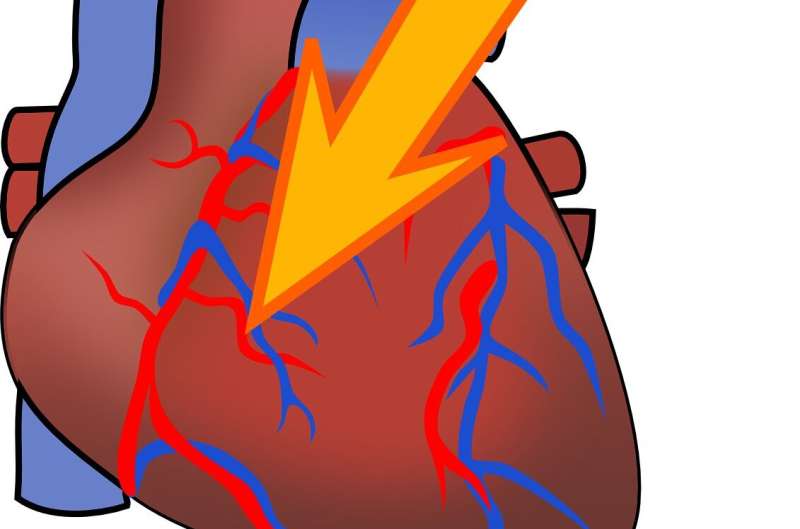This article has been reviewed according to Science X's editorial process and policies. Editors have highlighted the following attributes while ensuring the content's credibility:
fact-checked
peer-reviewed publication
trusted source
proofread
Racial disparities discovered in patients with cardiac devices

Black patients with implantable cardioverter defibrillators (ICDs) have a significantly higher burden of disease than white patients with the same device, according to a new study from University of Rochester Medical Center (URMC) cardiology researchers. Analyzing data from clinical trials conducted over a 20-year period by the Clinical Cardiovascular Research Center (CCRC) at URMC, investigators concluded that not only did Black patients with ICDs tend to be significantly younger than white patients, but they also had a higher rate of post-implant cardiac events and risk of death.
When a patient is at risk for cardiac arrest, an ICD helps to monitor their heart rhythm, and if an abnormality is detected, the device delivers a shock of electricity to reset the heartbeat to a normal rhythm. The study, published in Circulation, examines the rate of events that a patient experiences after their ICD is implanted. After three years of monitoring, the risk of ventricular arrhythmia (sustained rapid heartbeat that can lead to sudden cardiac death) was 20% for white patients, but 31% for Black patients. The other significant findings were that Black patients requiring an ICD appeared at younger ages, by five to ten years, and the risk of death for Black patients, despite having an ICD to protect them, is two times higher.
There are two types of heart failure. In one, a heart attack can leave a scar, which develops the potential for future heart failure. This is ischemic cardiomyopathy (ICM). In the other, heart failure is due to comorbidities, such as diabetes and hypertension. This is non-ischemic cardiomyopathy (NICM). An interesting note in the study shows there was virtually no difference in results for Black and white patients with ICM because the scar is essentially the same in both races, therefore they have the same issues and receive the same treatment. It's only in patients with NICM that there are stark differences between Black and white patients.
These results beg the question: Why? Principal investigator Ilan Goldenberg, MD, said they can hypothesize some reasons for the differences, but not fully draw solid conclusions.
"It is possible that Black patients are not managed as well as white patients because of health care disparities, but we did not identify any significant differences in our study. We did identify that after one year, Black patients were more likely to discontinue some medications, but the reasons for that are unknown as well. The younger age of onset and the increased rate of comorbidities, such as diabetes and hypertension, among Black patients with NICM is striking and may contribute to the worse outcomes due to more advanced heart disease," Goldenberg noted.
The authors applied the Gini Index to their results. This index looks at ZIP codes across the country to compare its citizens wealth to areas surrounding it. For this particular study, the index scores for patients indicated that Black patients did tend to come from areas with lower socioeconomic status. "Future studies should examine closely social determinants of health, which were not captured in our clinical trials, to see why these findings occurred," said Goldenberg.
Lead author Arwa Younis, MD is a former research fellow from the URMC Clinical Cardiovascular Research Center who is now at the Cleveland Clinic and still holds an adjunct position with URMC. Younis knew going into the study that there were differences between racial groups with ICDs, but he was surprised by the extent of the results.
"There's nothing worse than getting a shock for a patient," said Younis. "And it's difficult to see a patient continue to receive shocks despite being on optimal medical therapy. In our study, we assessed patient compliance at the one-year mark and more than 85% of patients remained compliant. So, despite being on optimal medical therapy and having a high compliance rate, the burden of disease remained very high for Black patients."
According to Younis, these results mean that Black patients with an ICD should receive aggressive positive treatment as early as possible. This means monitoring patients closely, referring to specialists as needed, and implanting devices earlier on.
Goldenberg agrees: "We believe the main implication of this study is that because we now know that Black patients who have heart failure are more likely to have more advanced arrhythmias, they should be considered earlier for an ICD defibrillator to protect them from sudden cardiac death." He also notes that primary prevention and treatment of comorbidities such as diabetes and hypertension may be one way to help prevent the burden of cardiac disease in Black patients.
Additional co-authors of the study from URMC include Sanah Ali, MD; Ido Goldenberg, MD; Scott McNitt, MS; Bronislava Polonsky, MS; Mehmet Aktas, MD; Valentina Kutyifa, MD, Ph.D.; and Wojciech Zareba, MD, Ph.D. Co-authors from the Cleveland Clinic include Eileen Hsich, MD and Oussama Wazni, MD, MBA.
More information: Arwa Younis et al, Arrhythmia and Survival Outcomes Among Black Patients and White Patients With a Primary Prevention Defibrillator, Circulation (2023). DOI: 10.1161/CIRCULATIONAHA.123.065367




















